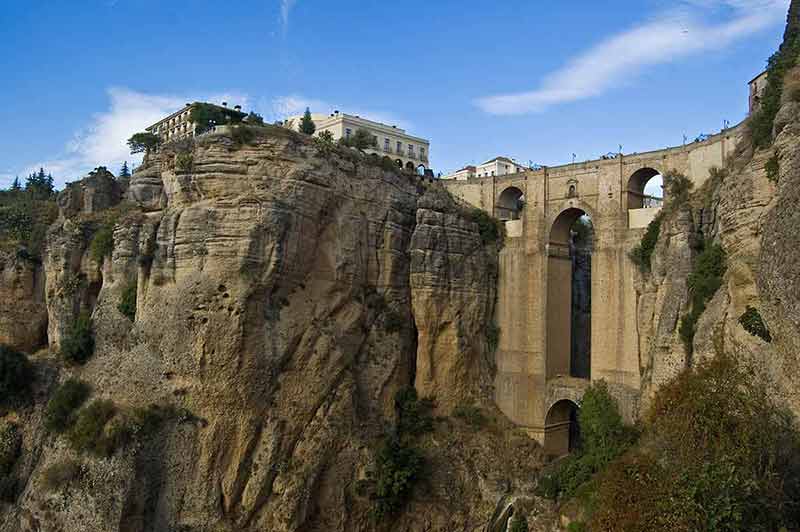Built on the edge of a towering cliff, and sharply divided by the massive gorge Tajo de Ronda, the Old Town of Ronda and its modern neighbourhood are bound together by the village’s most emblematic symbol, the Puente Nuevo. Ronda contains more than just unbelievable views of the Guadealevín River below, and the Sierra de Grazalema mountains in the distance.
The village has one of the most important parts of Spanish history with the oldest bullfighting ring in the country. It’s also the birthplace of this national tradition. Ronda’s significance to Spain’s historic culture was immortalised by the American writer Ernest Hemmingway in books such as ‘Death in the Afternoon’ where he mentioned the grand spectacle of the bullfight, and in ‘For Whom the Bell Tolls’ where an anecdote tells of the gruesome killings that took place in the village during the Civil War.
The Old Town of Ronda reveals the succession of Roman, Muslim, and Christian rule of this prized gem in Andalusia. Their creative designs are all intermingled through the churches and historic defensive walls. This exceptional mix of cultures tells the story of the village in a harmonious form as you walk down charming passageways and across stone bridges from centuries ago.
Contents
- Ronda, Spain
- Top Tours
- 20 Things To Do In Ronda
- 1- Cross The Puente Nuevo
- 2- Admire The Architecture of The Plaza de Toros de Ronda
- 3- Enjoy The Sunset At The Alameda Del Tajo Park
- 4- Walk Through The Puerta de Almocábar And Examine The Arab Walls
- 5- Discover The La Casa Del Rey Moro
- 6- See The Iglesia de Santa María la Mayor
- 7- Stop By The Convento de Clarisas Santa Isabel de los Ángeles
- 8- Pass Through The Cijara Gate
- 9- Learn About Muslim Traditions At The Arab Baths
- 10- Rest At The Jardins De Cuenca
- 11- Hike To The Puente Viejo and The Puente De San Miguel
- 12- Escape The Hot Sun In The Plaza Duquesa De Parcent
- 13- See The Exciting Collection At The Museo Lara
- 14- Explore The Mondragón Palace
- 15- Examine The Incredible Artefacts At The Museo Arqueológico Municipal
- 16- Go Back In Time At Casa Museo Don Bosco
- 17- Check Out The Plaza Del Socorro
- 18- Ponder Ronda’s Ancient History At The Acinipo Ruins
- 19- Take A Swim And See The Cueva del Gato in Benaoján
- 20- Interact With The Bulls and Horses At The Reservatauro Ronda
Ronda, Spain
20 Things To Do In Ronda
1- Cross The Puente Nuevo
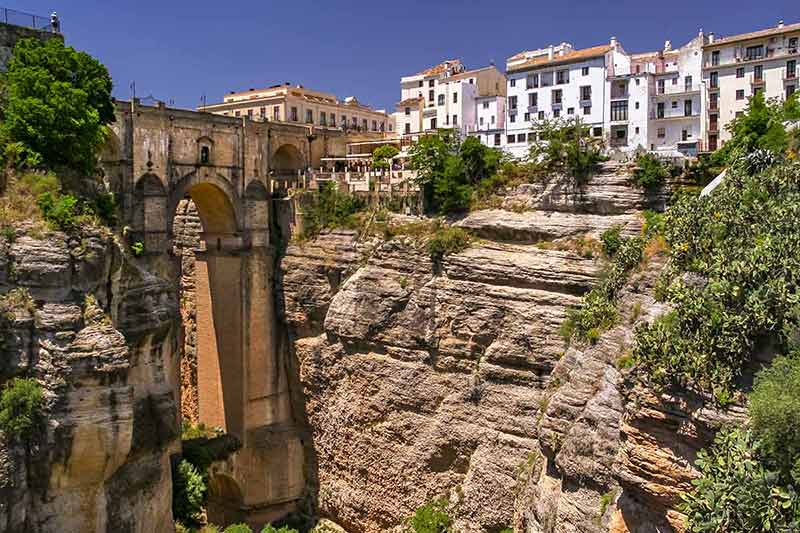
As Ronda’s most iconic structure, the Puente Nuevo or ‘new bridge’ represents a masterpiece of engineering and architectural design and reflects on the people and history of the village and how they are connected.
Bringing together the Old Moorish Town with the El Mercadillo, the more modern part of Ronda, the bridge links together two distinct periods of time in the Ronda’s past.
Spanning 70 metres across the Tajo de Ronda Gorge, and 98 metres above the Guadelevín River, this 18th-century bridge, and its imposing facade, sets Ronda apart from many of its nearby counterparts.
In the centre of the arch, you can see one of its most curious features.
A small window that brings light into what was formally a prison and torture chamber, but now houses the Puente Nuevo Interpretation Museum.
From multiple viewpoints on either side of the gorge, you can admire the stunning features of the massive stone bridge with long columns that extend deep below.
At night, the bridge becomes illuminated from all directions, bringing the structure to life as people wander back and forth trying to get the best angle for a photo.
The picturesque waterfall below Puente Nuevo is best accessed via a hiking tour but if you are an experienced climber, start your descent after passing through the Albergue Los Molinos restaurant.
Recommended tour: Ronda: Audio Guide Walking Tour with Puente Nuevo and Viejo
2- Admire The Architecture of The Plaza de Toros de Ronda
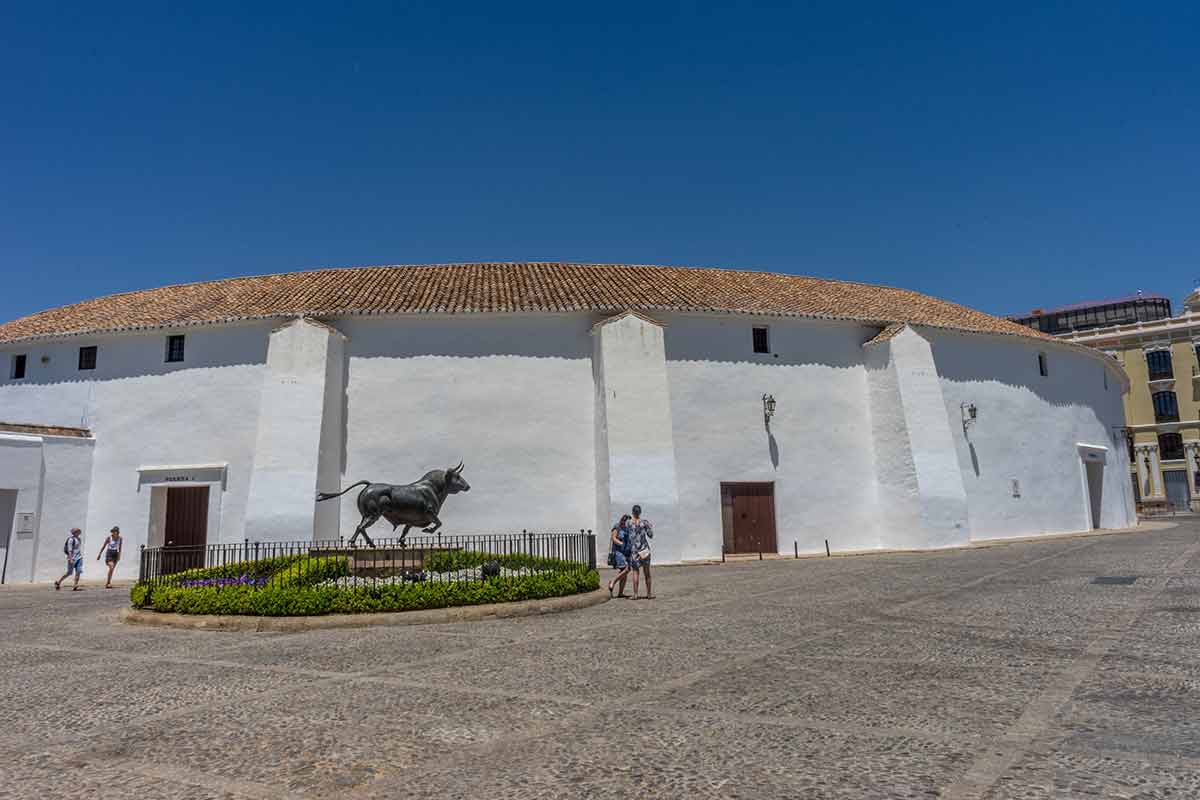
Many know Spain for its famous history of bullfighting and the impressive venues constructed for these events, and Plaza de Toros de Ronda is no exception.
As the oldest bullring in the country, completed in 1785, it has hosted many generations of bullfighters, including members of the famous Romero family.
Completely made from stone, the two-tiered stands feature Tuscany columns, with a capacity of up to 5,000 spectators.
It also contains the largest area of sand-covered surface of any bullring in the world.
The Plaza de Toro now attracts visitors to appreciate this magnificent work of architectural design and the museum dedicated to the history of bullfighting which contains weapons, costumes, and other bullfighting regalia.
Plaza de Toros de Ronda is at: C. Virgen de la Paz, 15, 29400 Ronda.
Recommended tour: Ronda: Guided Walking Tour
3- Enjoy The Sunset At The Alameda Del Tajo Park
Perfect for an evening stroll to catch the sunset, the Alameda Del Tajo Park offers magnificent panoramic views overlooking the Tajo de Ronda Gorge, the rolling countryside, and the beautiful mountains of Serranía de Ronda in the distance.
Next to the Plaza de Toros, five parallel walkways are lined with beautiful Himalayan cedars, three-throned acacias, and great stone pines, which provide plenty of shade and lead you to a series of breathtaking balconies.
This early 19th-century park represents a great example of a Mediterranean garden where bushes, trees, and plants make up the significant botanical features instead of grass or hedges.
Make sure you take time to discover the small duck pond, fountains, and some of the remarkable statues tucked away on the paths.
One of which is called the Goyesca Lady, a woman from Ronda dressed in a typical Goyesca costume.
You may also want to find the statue of Pedro Romero, Ronda’s most famous bullfighter, made by the sculptor Vicente Bolós in 1957.
This serene park is one of the village’s best places to relax before taking in some of the most breathtaking views of the region.
4- Walk Through The Puerta de Almocábar And Examine The Arab Walls
Serving as the grand entrance to the village during Moorish times, the Puerta de Almocábar and Arab walls clearly represent Ronda’s significance to Andalusia, while protecting the incredible treasures within.
The original construction of the walls began in the 1200s, but over centuries it was destroyed and reconstructed several times.
In this spot, King Ferdinand II defeated the Moors in 1485 to gain control of Ronda.
Over two centuries ago when Napoleon invaded Spain and Portugal nearly all the walls and gates were destroyed.
It wasn’t until 1960 that the Puerta de Almocábar was restored to the current version we see today.
Puerta de Almocábar is at: Pl. Ruedo Alameda, 29400 Ronda.
5- Discover The La Casa Del Rey Moro
Constructed upon the site of a 14th-century water mine, the Casa del Rey Moro is not actually the ‘House of the Moorish King’ but instead a former residence of the famous Salvatierra family.
It was later owned by the Duchess of Parcent who decided the renovate the building in a neo-Mudéjar style.
The mansion itself is currently undergoing renovations and is not open to the public, however, the gardens and stairs that bring you to the bottom of the El Tajo Gorge are still open to explore.
To reach this beautiful outdoor area split into three tiers, take the set of stairs decorated in ceramics.
Inside the terraces, you will find many water features and fountains among the brilliantly coloured flowers and ponds covered with water lilies, along with incredible scenic views.
The gardens were designed by the French landscaper and gardener, Jean Claude Nicolas Forestier in 1912.
To reach the bottom of the gorge and Guadalevin River below, you must descend 200 steps through the rocks to reach a spectacular viewpoint of the sheer rock faces above.
The La Casa Del Rey Moro is at: C. Cta. de Santo Domingo, 9, 29400 Ronda.
6- See The Iglesia de Santa María la Mayor
Ronda’s most famous church, Iglesia de Santa Maria la Mayor was originally constructed during the 14th century upon the site of a former mosque.
It was finally completed in the 17th century, but then in 1850, a strong earthquake struck the village and destroyed part of the original construction and it had to be reconstructed.
Throughout the building, you can find different influences on the architecture including Gothic, Mudéjar, Renaissance, and Baroque.
In the stunning interior of the church, you can find one feature not typically seen in most churches in Spain.
It’s an arch that forms part of the mihrab, a spot in the former mosque that directs you towards Mecca.
Recently in 2017, a new rooftop wooden patio was added to the Iglesia where you can enjoy the panoramic views of the city and surrounding mountains.
Since the Iglesia de Santa María la Mayor is the highest building in the historic quarter, it’s an excellent way to experience Ronda from above.
The Iglesia de Santa Maria la Mayor is at: Pl. Duquesa de Parcent, S/N, 29400 Ronda.
7- Stop By The Convento de Clarisas Santa Isabel de los Ángeles
Just a few metres from the town hall, the Convento de Clarisas Santa Isabel de Santa Isabel de los Ángeles is a convent that belonged to the nuns of the Order of Saint Clare under the rule of Saint Francis of Assisi.
Originally built in the 16th century and then later expanded and restored after suffering damages from the Spanish Civil War, the convent contains a single nave beautifully adorned with the artists’ vaults.
These decorations obscure the Mudéjar armour from centuries ago that is still visible in part of the upper choir.
The entrance to the church is through a stone doorway with a semicircular arch overhead that presents the shield of the order with two columns on either side.
Hints of the Mudejar style can be seen in the exterior and bell tower that rises above.
The Convento de Clarisas Santa Isabel de los Ángeles is at: Pl. Duquesa de Parcent, 5, 29400 Ronda.
8- Pass Through The Cijara Gate
As one of the original entrances to the old town part of Ronda, this gate contains three large stone arches that lead you down the Barrio Alto to the Arab Baths.
The stonework and arches of the gates are very well-preserved, and the heavy growth of bright green vegetation that grows on the steps of the path and walls adds to its charm.
The views as you descend are quite impressive as well, especially later in the afternoon.
Cijara Gate is at: C. Marqués de Salvatierra, 26, 29400 Ronda.
9- Learn About Muslim Traditions At The Arab Baths
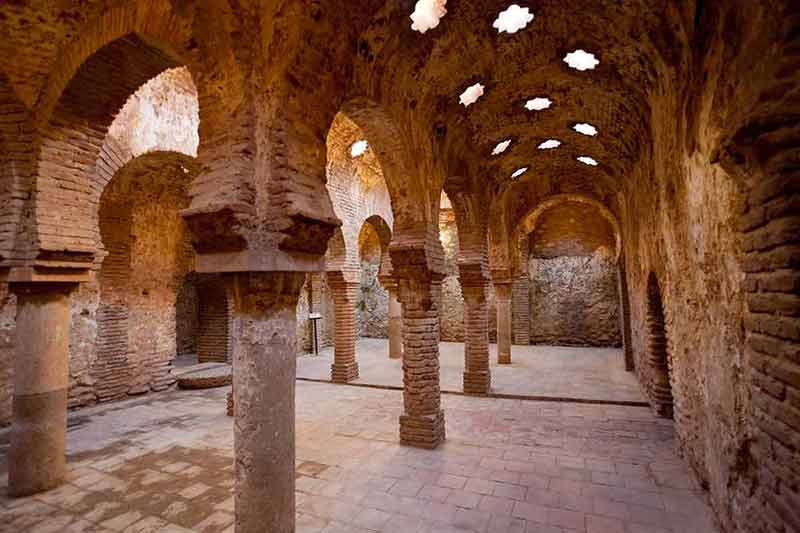
Built during the 13th and 14th centuries, the Arab Baths of Ronda are one of the best-preserved in the Iberian Peninsula.
It has some of the finest examples of Moorish architectural design with many columns topped by Islamic-style horseshoe arches, and barrel-vaulted ceilings with star-shaped skylights.
Similar to the Romans, the baths inside the complex used cold, warm, and hot spring water sourced from the Arroyo de las Culebras.
This ancient religious tradition serves more than a hygienic purpose, however.
Both locals and visitors used the baths to purify and cleanse their spirits from impure thoughts before entering the Mosque.
The Arab Baths are at: C. Molino de Alarcón, s/n, 29400 Ronda.
10- Rest At The Jardins De Cuenca
Dedicated to Ronda’s twin city of Cuenca because of their similarities in geographical layout, the Jardins de Cuenca bring you on a scenic journey above the Guadalevín River and gorge to the two lesser-known bridges of the village.
Along the stone path, stop and admire the flowers in the beautiful rose garden, look back at the impressive Puente Nuevo, and take in views of the Casa del Rey Moro and Convent of Santa Domingo on the opposite side of the gorge.
The Jardins De Cuenca is at: C. Escolleras, 1, 29400 Ronda, Málaga.
11- Hike To The Puente Viejo and The Puente De San Miguel
Often overshadowed by the magnificent Puente Nuevo Bridge near the edge of the village, the two lower stone bridges of Puente Romano and Puente Viejo also boast impressive structural designs with enormous arches that span across the river.
near the Arab Baths, the Puente Romano is often referred to as the ‘Roman Bridge’ despite being constructed long after Roman times, under the direction of the Muslim rulers.
The Puente Viejo was built in 1616 and amazingly contains only one single large semicircular arch to support its weight.
As the smallest and oldest bridge out of the three in Ronda, it’s often overlooked but still quite beautiful.
12- Escape The Hot Sun In The Plaza Duquesa De Parcent
The central square of the village, the Plaza Duquesa de Parcent is where the Roman Forum once stood long ago.
On the edges of the plaza, you will find some of Ronda’s most historic buildings including the Iglesia Santa Maria la Mayor, the Convento de Clarisas Santa Isabel de los Ángeles, and the Ayuntamiento (town hall) which was actually used as a prison for some time,
In the centre of the plaza, beautiful orange trees provide shade to a quiet area that circles a water fountain and statue of the Duchess of Parcent.
Surrounding the park, a number of restaurants offer outdoor seating with umbrellas to help escape the sun.
It’s the perfect place to have a cold drink or try some local tapas before you continue your tour of the village.
13- See The Exciting Collection At The Museo Lara
As the first private museum established in Andalusia and one of the most unique private museums in all of Spain, the Museo Lara contains a collection of over 2,000 intriguing pieces of work acquired by Juan Antonio Lara Jurado, a fantastic result of his life’s work.
Housed inside the Casa Palacio de los Condes de las Conquistas, the collection is divided into themed rooms such as antique scientific instruments, clocks, and weapons.
Fans of the macabre will certainly be delighted to see the fascinating exhibits related to the Holy Inquisition including artefacts that represent different instruments of torture such as hanging cages, an iron maiden, and a cradle of Judas.
Another exhibit has historic witchcraft potions and practices.
With all these rare pieces in one place, it’s hard not to let curiosity get the best of you.
The Museo Lara is at: C. Armiñán, 29, 29400 Ronda.
14- Explore The Mondragón Palace
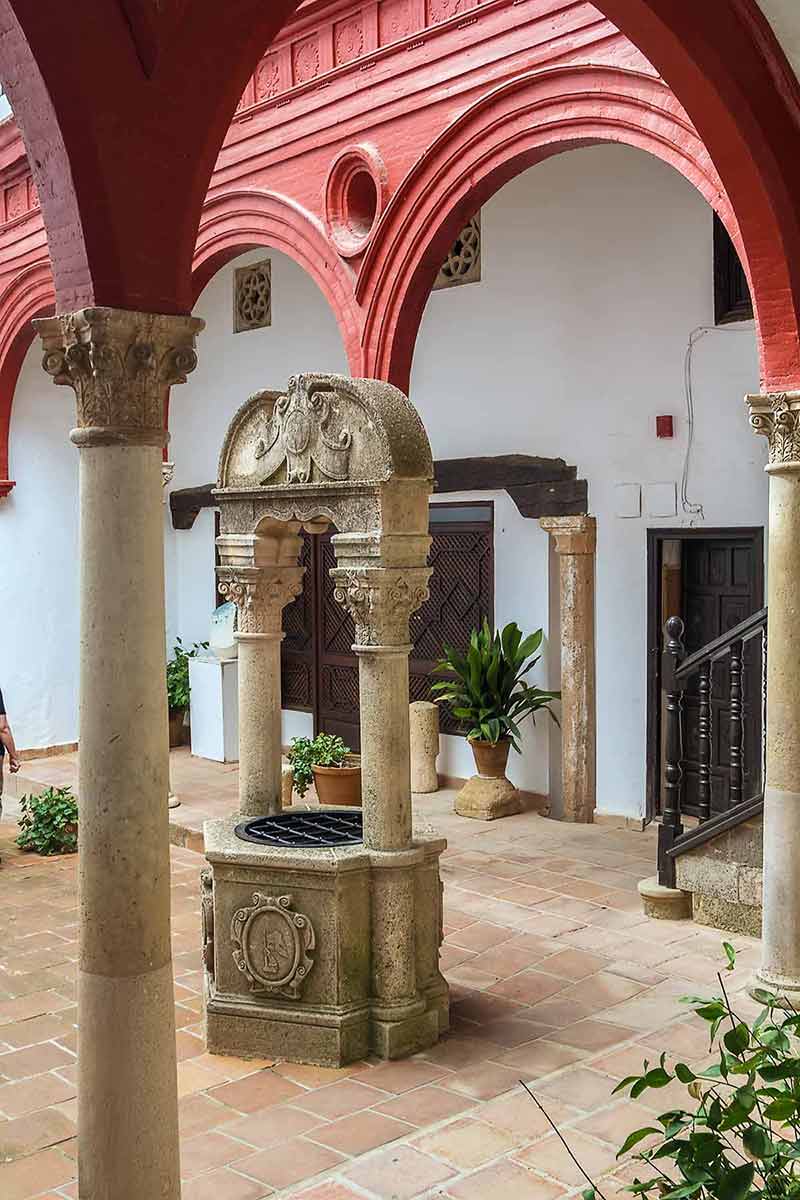
Shrouded in mysterious legends of the past, the intriguing Mondragón Palace has elements of Mudéjar and Renaissance architecture, but its most compelling features are actually found outside in the lush Moorish gardens that lead to the cliff’s edge.
Many believe the palace was originally built in the 14th century for the Moorish ruler Abbel Mallek, the son of the King of Morocco, and tiny remnants of Mudéjar style can still be seen in the ceilings, original tiling, and inner courtyard.
Later, it became the primary residence of King Ferdinand and Queen Isabella after conquering the village in 1485.
The palace now contains the Museo Arqueológico Municipal, one of Ronda’s most interesting museums.
Be sure and spend time enjoying the tranquillity of the water gardens filled with exotic flowers and fountains, and check out the wonderful views of the Sierra de Grazalema Mountains in the distance.
The Mondragón Palace is at Pl. Mondragón, s/n, 29400 Ronda.
15- Examine The Incredible Artefacts At The Museo Arqueológico Municipal
Housed inside the Mondragón Palace which dates back to the 14th century, the Museo Arqueológico Municipal displays a collection of artefacts mostly found in the region, from prehistoric times through Roman times.
In one section you find prehistoric relics that shed light into the lives of the cave-dwelling hunter-gatherers while examining their earliest innovations such as earthenware to metallurgy.
Another part of the museum focuses on the first Iberian settlements and Roman influences that came later with objects discovered nearby in Acinipo and Arunda.
The exhibits contain interesting coins, statues and other items from this time period.
The Museo Arqueológico Municipal is at: Pl. Mondragón, s/n, 29400 Ronda.
16- Go Back In Time At Casa Museo Don Bosco
Built during the 20th century in a modernist style, it was originally owned by a family from Granada before being donated to the Salesian Congregation in 1940.
The purpose of the donation was to turn the house into a place for ill priests of the Salesians to find health and rest.
The house is decorated with lavish furniture from this period, but its most impressive feature is the garden and patios that overlook the Serranía de Ronda.
Casa Museo Don Bosco is at: C. Tenorio, 20, 29400.
17- Check Out The Plaza Del Socorro
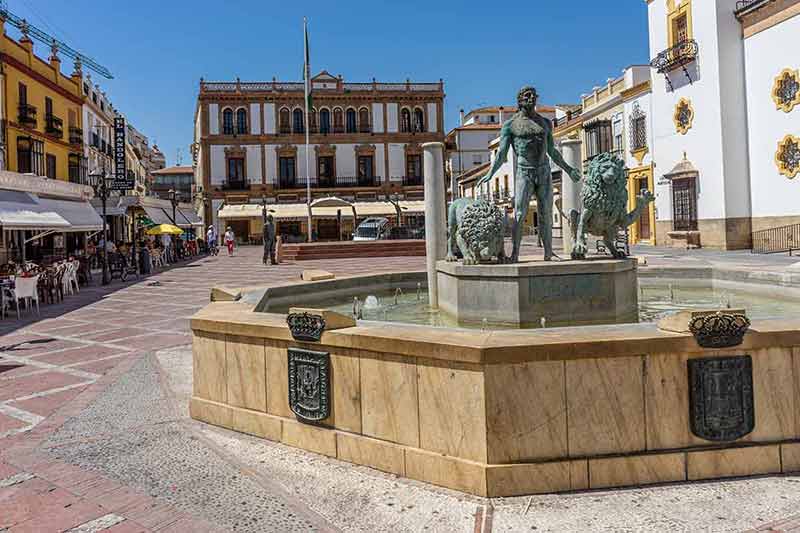
Set in the middle of the Old Town of Ronda, the Plaza del Socorro presents a lively local atmosphere day and night with outdoor cafes and restaurants surrounded by historic buildings and neighbourhoods of the village.
The square is famous for being the place where the Andalusian flag was first revealed to the public.
The most important landmark on Plaza del Socorro is the Parroquia de Nuestra Señora del Socorro church built around 1956, replacing two previous churches that were demolished at different points in time.
Plaza del Socorro is at: Pl. del Socorro, 15, 29400 Ronda.
18- Ponder Ronda’s Ancient History At The Acinipo Ruins
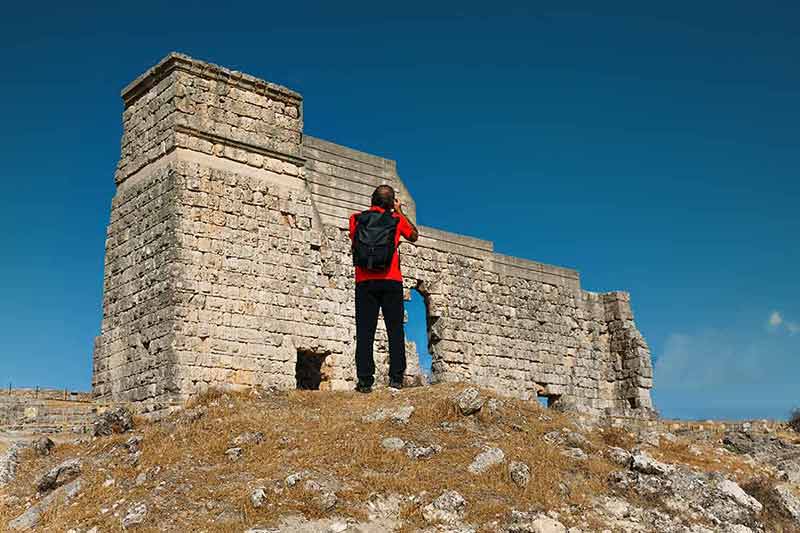
To dig into Ronda’s earliest roots, travel 15 km north of the village to the Acinipo Ruins.
Known widely as Ronda la Vieja (Old Ronda) the ruins are the remnants of an urban area that used to have a population of 5,000 people back in the first century AD.
The ruins contain circular huts from the Bronze Age, a Roman theatre with seating for 2,000 people, and partially restored Roman thermal baths where you can see the caldarium, tepidarium, and changing rooms.
This hilltop also provides incredible scenery and is a hotspot for hand-gliding enthusiasts.
The Acinipo Ruins is at: C. Virgen de la Paz, 29400 Ronda.
19- Take A Swim And See The Cueva del Gato in Benaoján
Only 15 km to the west of Ronda, the Cueva del Gato in Benaoján offers a splendid place for an afternoon swim on a hot summer day.
The Cueva del Gato or ‘cat cave’ is an 8 km long cave system within the Sierra de Grazalema and earned its name for its entrance which resembles a cat’s face.
Just below the Cueva del Gato, you will find an enchanting pool of crystal-clear cold water, surrounded by lush vegetation.
It’s perfect for taking a dip and pondering the wonders within the cave.
It’s not possible to enter the cave for safety reasons.
The waters can rise rapidly after a storm creating a dangerous situation.
To reach the Cueva del Gato, you must first cross the Guadiaro River from the parking lot, and hike another 150 metres to the swimming area.
The Cueva del Gato is at: MA-7401 Km 3 Carretera de, 29370 Benaoján.
20- Interact With The Bulls and Horses At The Reservatauro Ronda
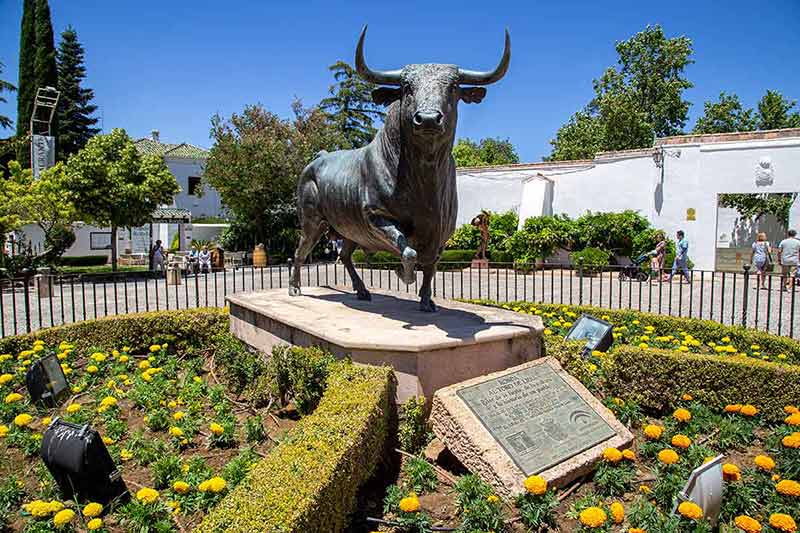
Ronda’s heritage of bullfighting is well known throughout the country, and at the Reservatauro Ronda, you can see how the fighting bulls and pure Andalucian horses are bred and raised, and even interact with them!
Although bullfighting events no longer take place in Spain, it’s fun for people of all ages to be immersed in all the aspects of this active farm.
A guided tour teaches you about the selection process, and bull-keeping practices, and gives you a chance to see the bulls up close.
only five kilometres from Ronda, the nature reserve presents a unique perspective on one of Spain’s most famous traditions, and how its legacy is being preserved today.
The Reservatauro Ronda is at: Carr. Ronda Campillos, km 34, 29400, Málaga.
Recommended tours:
Love Spain? Read these posts:
- 27 Spanish Shows On Netflix
- 20 Fairytale Castles In Spain
- 30 Landmarks in Spain
- 20 Places To Visit In Spain In Winter
- 20 Best Beaches In Spain
- An Amazing Andalusia Road Trip
- 20 Things To Do In Ibiza
- 20 Things To Do In Tenerife
- 21 Things To Do In Lanzarote
- 21 Spanish Drinks To Try
- 20 Things To Do In Madrid At Night
- 20 Day Trips From Madrid
- Best Time To Visit Spain
- 20 Cities in Spain
- Renting A Car In Barcelona
- 20 Things To Do In Seville
- 20 Things To Do In Granada
- 20 Things To Do In Zaragoza
- 20 Things To Do In Palma
- 20 Tours In Spain
- 20 Things To Do In Alicante
- 20 Spanish Food / Dishes
- 20 Things To Do In Ronda
- 20 Things To Do In Cadiz
- 20 Thing To Do In Benalmadena
- 20 Things To Do In Torremolinos
- 20 Landmarks In Barcelona
- 5 Day Trips From Barcelona
- Barcelona Bike Tour
- 10 Things To Do In Bilbao
- 12 Things To Do In San Sebastian
- 10 Things To Do In Oviedo
- Storybook Village of Santillana del Mar
- 20 Things To Do In Gran Canaria
- 20 Things To Do In Barcelona At Night
- Christmas in Spain
- 20 Things To Do In Malaga
- 20 Things To Do In Marbella
- 20 Things To Do In Valencia
- Where To Stay In Valencia
- Ibiza At Night
- 20 Things To Do In Ibiza
- 20 Things To Do In Toledo
- Where To Stay in Barcelona
- 20 Things To Do In Segovia
- Where To Stay in Tenerife
- Where To Stay in Madrid
- Where To Stay In Mallorca
- Where To Stay In Ibiza
- 15 Things Spain Is Famous For
Plan Your Trip

Rent A Car – Find the best car rental rates at Discover Cars. They compare car hire companies to provide you with the best deal right now.

Find A Hotel – If you’re curious about this article and are looking for somewhere to stay, take a look at these amazing hotels.
